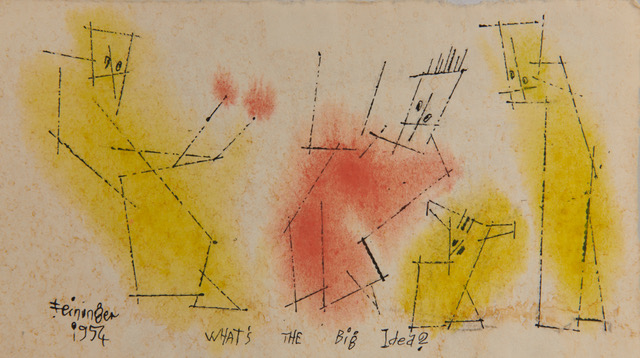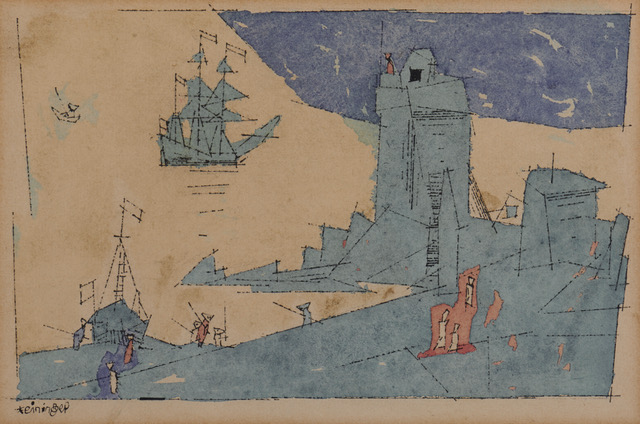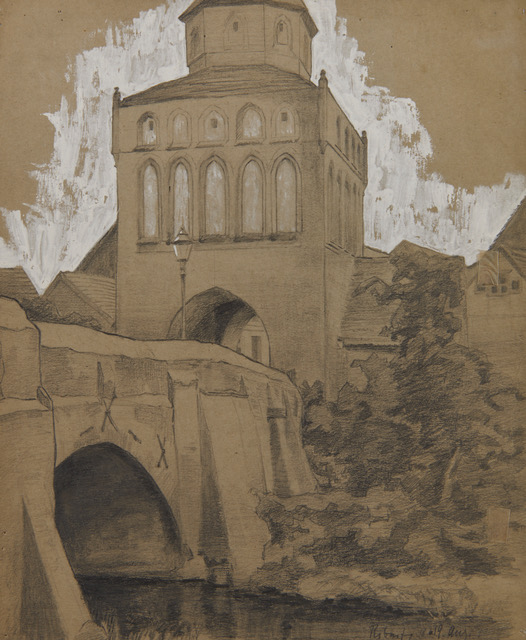Dear All,
May this find you well and enjoying a beautiful start to the summer. The end of this weekend offers us a wonderful treat in the art world, an auction featuring a curated selection of never-before-seen works from artist Lyonel Feininger (1871 – 1956). The collection comes directly from the son of the artist, T. Lux Feininger, and is more than just a body of work — these are personal mementos from the artist’s life that offer a unique and rare glimpse into his art and history itself. I have worked closely with the Feininger family on this sale and am excited to see it come to fruition.

Lot 116: Lyonel Feininger, What’s The Big Idea? (Four Ghosties), 1954, ink and watercolor, 3 5/8 x 6 3/8 in.
The collection, which will feature an assortment of works on paper — watercolors, sketches, and ink drawings — some even adorning handwritten inscriptions and dedications to his sons (see Lot 112 for a self-portrait of Feininger holding one of the two), and greetings to friends (Lots 153-177) — demonstrates the sheer breadth of artistic skill and spirituality that was ever-present throughout the entirety of his career. Buyers and viewers will have the opportunity to access some of his never-before-seen works that exemplify his steadfast exploration of an “observed reality,” one he famously elicited through his naturalistic motifs, color notes, and natur-notizen (his “nature eye” as an artist).

Lot 108: Lyonel Feininger, The Watch Tower, 1947, watercolor and ink, 6 1/4 x 9 7/8 in.
We see an example of this in Lot 118, an assembly of 17 colored-pencil and lead sketchbooks loosely titled, “While riding on the railroad,” which offer a window into this style through images of, (according to Feininger’s notes), “bright green grass between tracks, white signals” and a “dark green carriage with dr. violet curtains golden stripes.” Also through Lots 108, 113, and 115 in his visions of summer escapes on the Baltic Sea.

Lot 113: Lyonel Feininger, Untitled (Ribnitz Town Gate), pencil heightened with white, 13 1/2 x 10 7/8 in.
The collection will also feature several works by friends of Feininger including artists Alfred Kubin, Franz Marc (from “The Blue Ride”), and Erich Heckel and Karl Schmidt-Rottluff (from “The Bridge”).
The auction is being held this Sunday, June 3rd, by Grogan & Company in Boston. It is a gift that we have the opportunity to see these works and I highly encourage you to dive deeper. I have posted an article on the blog with a more detailed write-up on some of the pieces up for auction as well as a brief history of the artist. You may find it here.
As always, if you would like to dive into any of these topics further, need advice regarding this auction or any other happenings in the art world or would like to discuss any of your other art needs, I invite you to reach out.
I look forward to hearing from you and wish you wonderful summer.
Warm regards,
Bill Cottingham
__________
On the Artist and The Feininger Collection Auction
Lyonel Feininger was born in 1871 in New York City. Growing up in a German Roman Catholic household to a pianist mother and violinist father meant that his home was one whose only other higher power was music and art. While Feininger’s extreme musical talents were evident from a young age — his parents sent him to the Leipzig Conservatory in Germany to continue his musical studies at the young age of 16 — he ended up applying to Hamburg’s art school with a portfolio of sketches and drawings he’d brought with him from New York.
Highly gifted, Feininger excelled in the German art school before going on to enter studies at the prestigious Royal Academy in Berlin in the late 80’s. He was soon able to begin earning a living by drawing caricatures for a variety of publications and spent most of his free time exploring the streets and playing around with different art mediums.
At 21, Feininger headed to Paris to continue sketching — the Parisian architecture, locals he passed on the streets and live models in his French drawing classes-he much preferred the liberation of living and breathing models to those plaster ones at the German academy. His devotion to drawing and constant documentation and observation of his surrounds was base on which Feininger developed his eye that was fortified by natur-notizen, or “nature notes.”

Lot 110: Lyonel Feininger, Untitled (Marine View), 1949, watercolor and ink, 5 1/8 x 24 in.
A large selection of the works in the auction offers compelling examples of this characteristic for which Feininger was notorious, exhibiting motifs of the natur-notizen throughout their pages. Lot 118 in the auction, an assembly of 17 colored pencil and lead sketchbooks loosely titled “While riding on the railroad,” offer a window into this style through images of “bright green grass between tracks, white signals” and a “dark green carriage with dr. violet curtains golden stripes.”
For nearly a decade of the early 1900’s, Feininger would dedicate himself to this practice while continuing to make his living off cartoon drawings. He married musician and artist, Julia Lilienfeld Berg in 1905 and the two spent their summer in the town of Ribnitz. Lots 108, 113, and 115 in the collection draw beautiful visions of their summer escapes on the Baltic Sea. The two began to split their time between Germany and Paris, and later gave birth to their son, Andrews, in late 1906; likely the toddler that we see Feininger hold in a self-portrait in Lot 112.
Towards the latter end of that decade, Feininger moved on towards oil painting, bringing with him the inspiration and skillset he had evolved with his natur-notizen eye. This became the foundation for his oil painting, one in which an alleged reality became his “observed reality.”
As the early 1900’s progressed, the art scene in Berlin grew and evolved, becoming quickly celebrated with groups such as “The Blue Ride” and “The Bridge.” Feininger, quickly became a part of it, creating many friendships with other artists such as Alfred Kubin, Franz Marc (from “The Blue Ride”) and Erich Heckel and Karl Schmidt-Rottluff (from “The Bridge”). We gain a beautiful and intimate window into the lives of these artists, who often exchanged works, greetings, and thoughts. We can see some examples of these in Lots 153-177.
As World War began, Feininger became trapped between the two nations with which he had called home over the last few decades — an American at odds with the decades that shaped him as an artist, and a man, in Germany. During this time, Feininger turned yet again to another medium, woodcuts — which he noted in a letter “crashed into this technique with a passion to compensate for its belatedness in my career” — and inspired him to play into the spaces of negative and position on a planar compositional level. We see how he was still able to successfully and gracefully translate his natur-notizen into yet another medium in Lot 127.
After the war, Feininger — invited by Walter Gropius of the “State Bauhaus” in Weimar — went on to teach painting and drawing alongside the spirituality of creating art. In 1921, the focus of the school seemed dominated on abstraction, something that highly upset Feininger, he stopped teaching and became a master of the graphics workshop — overseeing published portfolios and printed matter — instead.
As the starting signs of WWII emerged and the power of Nazi’s started to rise over Germany, Feininger made the decision to move his family back to the States in 1937. Shortly after his departure, 24 of his works in the Entartete Kunst exhibition in Munich and 460 of his other works were confiscated by the Reich’s Chamber of Art.
After five decades spent away, Feininger found himself living again in his childhood home, New York City. It was in 1944 when the Museum of Modern Art hosted a Feininger retrospective exhibit that his identity as one of the most important artists of the 20th century was solidified. Although he had spent 50 years away from the US, his return and repositioning as an American artist played a largely important part in his success. Feininger died at the age of 85 at his home in Manhattan, he legacy lives on through his works and the Expressionist movement.
_____
